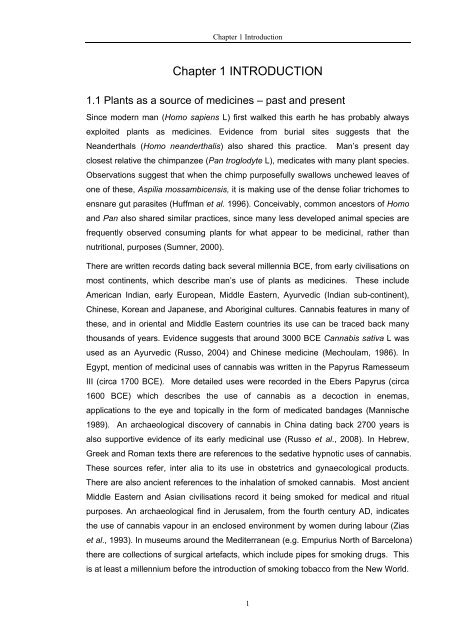finalfullthesisdjpotter
finalfullthesisdjpotter
finalfullthesisdjpotter
Create successful ePaper yourself
Turn your PDF publications into a flip-book with our unique Google optimized e-Paper software.
Chapter 1 Introduction<br />
Chapter 1 INTRODUCTION<br />
1.1 Plants as a source of medicines – past and present<br />
Since modern man (Homo sapiens L) first walked this earth he has probably always<br />
exploited plants as medicines. Evidence from burial sites suggests that the<br />
Neanderthals (Homo neanderthalis) also shared this practice. Man’s present day<br />
closest relative the chimpanzee (Pan troglodyte L), medicates with many plant species.<br />
Observations suggest that when the chimp purposefully swallows unchewed leaves of<br />
one of these, Aspilia mossambicensis, it is making use of the dense foliar trichomes to<br />
ensnare gut parasites (Huffman et al. 1996). Conceivably, common ancestors of Homo<br />
and Pan also shared similar practices, since many less developed animal species are<br />
frequently observed consuming plants for what appear to be medicinal, rather than<br />
nutritional, purposes (Sumner, 2000).<br />
There are written records dating back several millennia BCE, from early civilisations on<br />
most continents, which describe man’s use of plants as medicines. These include<br />
American Indian, early European, Middle Eastern, Ayurvedic (Indian sub-continent),<br />
Chinese, Korean and Japanese, and Aboriginal cultures. Cannabis features in many of<br />
these, and in oriental and Middle Eastern countries its use can be traced back many<br />
thousands of years. Evidence suggests that around 3000 BCE Cannabis sativa L was<br />
used as an Ayurvedic (Russo, 2004) and Chinese medicine (Mechoulam, 1986). In<br />
Egypt, mention of medicinal uses of cannabis was written in the Papyrus Ramesseum<br />
III (circa 1700 BCE). More detailed uses were recorded in the Ebers Papyrus (circa<br />
1600 BCE) which describes the use of cannabis as a decoction in enemas,<br />
applications to the eye and topically in the form of medicated bandages (Mannische<br />
1989). An archaeological discovery of cannabis in China dating back 2700 years is<br />
also supportive evidence of its early medicinal use (Russo et al., 2008). In Hebrew,<br />
Greek and Roman texts there are references to the sedative hypnotic uses of cannabis.<br />
These sources refer, inter alia to its use in obstetrics and gynaecological products.<br />
There are also ancient references to the inhalation of smoked cannabis. Most ancient<br />
Middle Eastern and Asian civilisations record it being smoked for medical and ritual<br />
purposes. An archaeological find in Jerusalem, from the fourth century AD, indicates<br />
the use of cannabis vapour in an enclosed environment by women during labour (Zias<br />
et al., 1993). In museums around the Mediterranean (e.g. Empurius North of Barcelona)<br />
there are collections of surgical artefacts, which include pipes for smoking drugs. This<br />
is at least a millennium before the introduction of smoking tobacco from the New World.<br />
1


